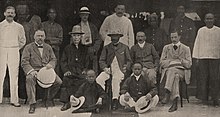Malaysian Chinese
They belong to diverse ethnic Han subgroups such as the Hokkien and Fuzhou from Fujian, the Teochew, Cantonese, and Hakka from Guangdong, the Hainanese from Hainan and Kwongsai from Guangxi.[6] The first recorded movement of people from China into present-day Malaysia was the 1292 arrival of Mongol expeditionary forces under Kublai Khan in Borneo in 1292 in preparation for their invasion of Java the following year.[17] According to Hai Yü (Words about the Sea), written by Huang Zhong and published in 1537, the lifestyle of the Chinese community in Malacca differed from that of the local Malays.[31] The Chinese emperor was reluctant to help the deposed Malaccan ruler reclaim his position, however, since the dynasty's foreign policy was changing to maintain friendly relations with the Portuguese.[31][32] His successor, the Jiajing Emperor, changed the attitude of the Ming court by executing two government officials and reaffirming the importance of Malaccan issues in major policy decisions.[58][62] Before the 1911 Xinhai Revolution which overthrew the Qing dynasty in China, Tongmenghui leader Sun Yat-sen raised funds and organisational support from overseas Chinese communities (primarily in French Indochina, the Dutch East Indies, the Philippines, Siam, British Singapore, Malaya and Borneo) and began Nanyang organising activities in Saigon, Hanoi, Pontianak, Manila, Bangkok, Singapore and George Town.[74] The MPAJA (primarily consisting of ethnic Chinese in Malaya) waged a guerrilla war against the Imperial Japanese Army (IJA) with 10,000 men in eight battalions, and contacted the British Force 136.[81] British intelligence estimated MNLA support at about 500,000, out of a total Chinese population of 3.12 million; battling the insurgents was difficult, since most hid in inaccessible jungles.[98] According to Chin Peng, the success of Templer's campaign was primarily due to the Briggs Plan's resettlement programme;[99] Gurney also introduced a quasi-ministerial system, with a bill to increase the number of non-Malays eligible for citizenship after independence.[100] After the 1949 Chinese Communist Revolution, foreign missionaries in China were forced to leave; Templer invited them to Malaya to provide spiritual healing, medical education and welfare measures to residents of the new government villages.[104] The anti-communist campaign continued until 1960, when the Malayan government declared the end of its state of emergency after Chin Peng demobilized his forces and left his hide-out in southern Thailand for Beijing via North Vietnam.You know the line they were taking with growing truculence on a heavy racial accent, the intimidatory postures and the snarling guttural notes on which they sent out their signals to their followers on the basis of the race lead us to only one conclusion -- that if this goes on, Malaysia will not belong to Malaysians.Of its 33 parliamentary seats contested in the election, the MCA retained 13 and lost control of the Penang state government to GERAKAN; Chinese-Malay tensions culminated in the 13 May incident.[136][137][145] The Taiping Rebellion in the mid-19th century caused much chaos and suffering in southern China, which led many ethnic Chinese civilians to seek refuge overseas, particularly to the Nanyang region (Southeast Asia) in further south.[148][149] Another large group, the Hakka are mostly hill farmers originated from northeastern Guangdong and various southern China places who specialise in forest clearance, mining as well on metalworking.[157] Within Peninsular Malaysia, Hokkien is predominantly spoken in west coast cities such as George Town, Seberang Perai, Klang, Malacca, Batu Pahat and Muar.[159][168] The first census conducted in 1970 after Malaysia was formed in 1963 reported that there were 3,555,879 ethnic Chinese Malaysians, with the Hokkien or Min Nan (福建人 or 闽南人) being the majority at 32.4%, followed by Hakka (客家人) at 22.1%, Cantonese (广府人) at 19.8%, Teochew (潮汕人) and Hainanese (海南人) at 12.4% and 4.7% respectively.[1] There is also a small community of Huáběi-ren (Northern Chinese or 华北人) in Sabah whose ancestors coming from various parts of Hebei (河北) and Shandong (山东) provinces in China with most of them calling themselves as Tiānjīn-ren (天津人 or 津侨).Besides that, Sanjiang-ren (Chinese: 三江人) is a collective term used to categorise the group of people whose ancestors hailed from Shanghai (上海), Zhejiang (浙江), Jiangsu (江苏), Hubei (湖北) and Jiangxi (江西).[188] The growing Islamisation with "Islamic version of non-tolerant and open", increasing racism within the Malay party members throughout the coalition imposing further into the country social demographics as well as the government discriminative policies on their education and employment, caused further disenchantment among non-Malays, especially ethnic Chinese.[189][190] This subsequently caused dwindling support from ethnic Chinese Malaysians when many original strongholds of MCA constituents and even Gerakan turned to the Democratic Action Party (DAP) as the latter were seen as more vocal on their rights.[191][192][193] The recent country general election in 2018 saw the fall of National Front coalition following additional aid from Bornean parliamentary seats particularly in Sabah that were won by Pakatan Harapan coalition ally of regionalist Sabah Heritage Party (WARISAN) as well from another indigenous party of United Pasokmomogun Kadazandusun Murut Organisation (UPKO) as a result of similar growing frustration over long-time manipulation of the state demographics and resources with lack of development through the administration of the Malay-led supremacists government of UMNO with frequent labelling as "fixed deposit state".[216] The massive ethnic Chinese migration during the British colonial period causing a subsequent strong influence on the country's culture, including in cuisine and the language.[227] The term Na Tuk originated from the Malay word of Datuk (grandfather) which then merged with Kong (公, sometimes addressed as 'Kung' meaning elderly male), similar with Tu Ti Kung (Chinese: 土地公), an earth deity worshipped in East Asia.Their technique of stir frying ingredients and adding a small portion of cooking oil over high heat in a wok (锅) is widely adopted among the nation.[232] Some examples of basic Chinese Malaysians drinks that are commercially produced in the country include the black tea, chrysanthemum tea, grass jelly, green tea, jasmine tea, soy milk and white coffee while popular snacks including the cakoi (油炸鬼) (long deep-fried dough), egg tart, hum ji peng (咸煎饼) (circle shaped fried dough with or without fillings), ngoi sing tart (外星塔) (UFO shaped tart), ngo hiang (炸五香) (various spiced, minced meat rolls prepared in deep fried style and served with vegetables), pau (包) (steamed buns), popiah (薄饼) (fried or plain spring rolls filled with mixed vegetables), and tau sar piah (豆沙饼) (pastry biscuits filled with a sweet or savoury filling).[237] The 1970 Malaysian Census reported the Southern Min dialects being the largest which accounting for 34.2% of the country Chinese population, followed by Hakka with 22.1%, Cantonese by 19.8%, Chaozhou (Teochew) by 12.4% and Hainanese by 4.7%.[170] In 2003, a more detailed statistics for each dialects reported the Hokkien with 2,020,914, Hakka with 1,092,835, Cantonese with 1,068,008, Teochew with 497,280, Fuzhou with 251,553, Hainanese with 141,045, Kwongsai with 51,674, Henghua with 24,654, Hockchia with 14,935 and different other ethnic Chinese with 202,977, for a total of 5,365,875.[243][244] Similar studies on Eastern Min speakers of Fuzhou community in Sarawak also found a general shift of language choice from their own dialect to Mandarin Chinese and English.[267] Most early Chinese churches including Baptists, Methodists and Presbyterians have their origins from missionary migrants that introduced the missions established in China to Malaysia.


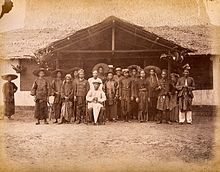
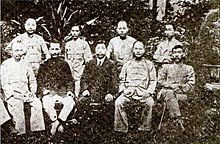

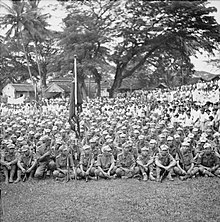


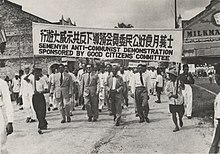


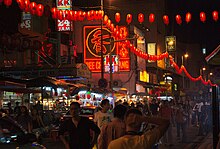



Undetermined majority

Bright red indicates a higher proportion of ethnic Chinese
Bright green indicates a higher proportion of
ethnic Malay or indigenous people
Mixed colour means that the ratio of the two is equivalent
The brownish colour are the area with the higher proportion of other non-indigenous races (such as
Indians
)




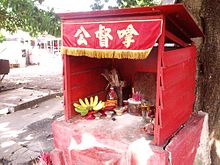



Small Chinese-speaking minority (
Brunei
)



Malaysian MandarinMalaysian diasporaumbrellaMalaysiaPenangKuala LumpurSelangorSarawakNegeri SembilanMalaccaAustraliaChristmas IslandSingaporeNew ZealandUnited StatesCanadaUnited KingdomTaiwanHong KongMainland ChinaMandarinEnglishHokkienCantoneseTeochewFuzhouHainaneseTaishaneseHenghuaManglishMahāyāna BuddhismTaoismChinese folk religionHinduismChristianityNon-religiousBruneian ChineseSingaporean ChineseIndonesian ChineseChinese FilipinosThai ChinesePeranakansSino-NativesOverseas ChineseTraditional ChineseSimplified ChineseStandard MandarinHanyu PinyinWade–GilesTongyong PinyinYue: CantoneseYale RomanizationJyutpingSouthern MinMalaysian citizensHan ChineseMalay majoritycountry's economySouthern ChineseKwongsaiPeranakanKelantanTerengganuBaba-NyonyaBorneoHuarenWàhyàhnHistory of MalaysiaKinabatangan DistrictMartin JohnsonMalay ArchipelagoMalay PeninsulaMongolKublai Khaninvasion of JavaKinabatangan Riverindigenous peopleMing dynastyYongle EmperorZheng Heseveral expeditions to south-east AsiaMa HuanYingya ShenglanconvertedMingshiTwenty-Four HistoriesNanyangMalaysBruneithalassocracyMajapahitAyutthayainterethnic marriagespread of Islam in the Malay ArchipelagoChinese MuslimFujianCantonIndonesiaPenang IslandBukit CinaPortuguese Malacca1511 conquestZhengde EmperorJiajing EmperorGuangdonghuman capitalHai San Secret SocietyCaptain Chinatakeover of Malaccatin minesFourth Anglo-Dutch WarMalayatycoonLabuanBritish BorneoNorth Borneo Chartered CompanyagriculturalRaj of SarawakCharles BrookeDayak peoplebazaarblack-pepperKuchingDutch BorneoCantonese peoplePahang
